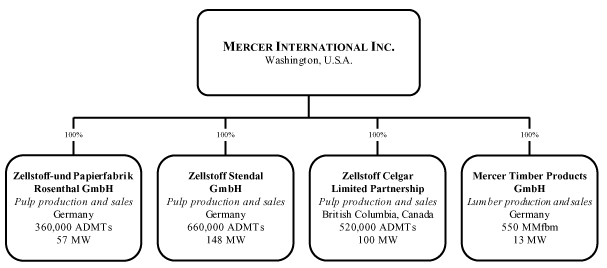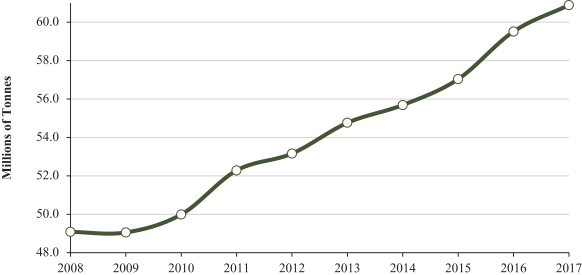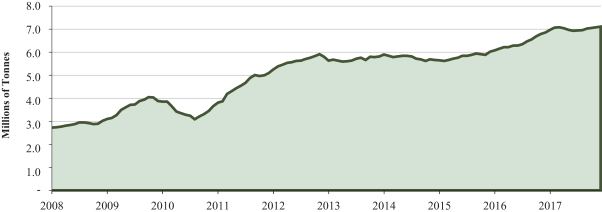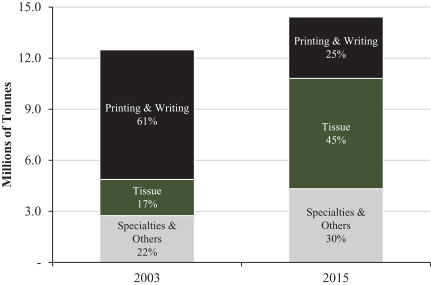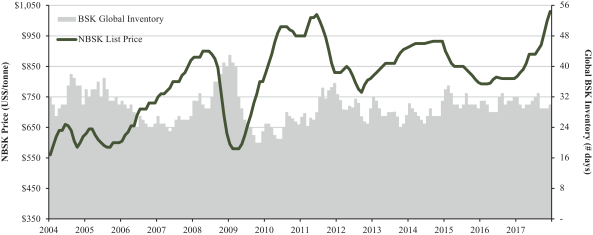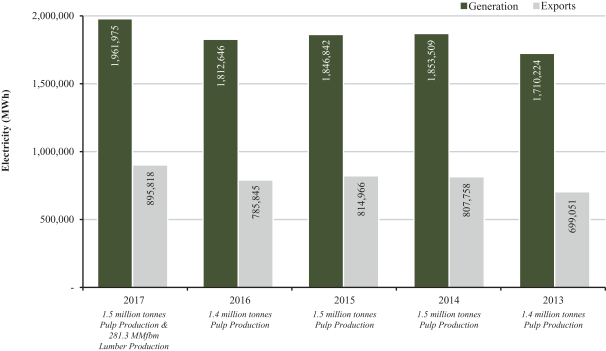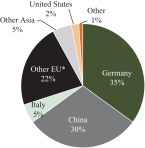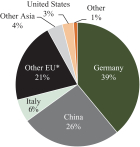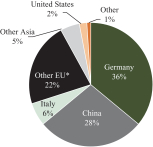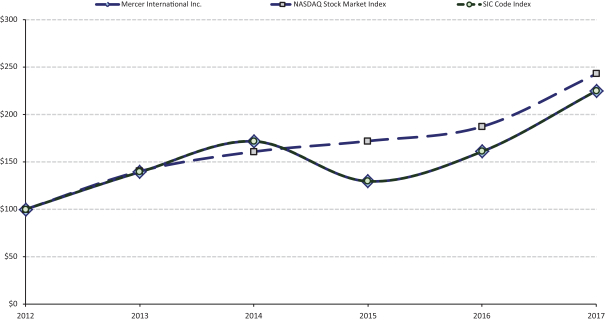conditions beyond our control determine the prices for pulp and lumber, prices may fall below our cash production costs, requiring us to either incur short-term losses on product sales or reduce or cease production at one or more of our mills. Therefore, our profitability depends on managing our cost structure, particularly raw materials which represent a significant component of our operating costs and can fluctuate based upon factors beyond our control. If the prices of our products decline, or if prices for our raw materials increase, or both, our results of operations and cash flows could be materially adversely affected.
A weakeningCyclical fluctuations in the price and supply of the global economy, including capital and credit markets,our raw materials, particularly fiber, could adversely affect our businessbusiness.
Our main raw material is fiber in the form of wood chips, pulp logs, sawlogs and financial resultslumber. Fiber represented approximately 55% of our pulp cash production costs and haveapproximately 75% of our lumber cash production costs in 2023. Fiber is a material adverse effect oncommodity and both prices and supply are cyclical. Fiber pricing is subject to regional
market influences and our liquiditycosts of fiber may increase in a region as a result of local market shifts. The costs of wood chips, pulp logs and capital resources.
Assawlogs are primarily affected by the supply and demand for our products has principally historically beenlumber. Demand for these raw materials is generally determined by general global macro-economic activities,the volume of pulp and paper products and solid wood products produced globally and regionally.
Governmental regulations related to the environment, forest stewardship and green or renewable energy can also affect the supply of fiber. In Europe, governmental initiatives to increase the supply of renewable energy have led to more renewable energy projects, including in Germany. Demand for wood residuals from such energy producers has generally put upward pressure on prices for wood residuals. In addition, the reduction in natural gas supply and increase in energy prices in Germany resulting from the Ukraine war has also increased both the demand and prices for wood chips and residuals. This has resulted in higher per unit fiber costs for our productsGerman mills.
The lumber industry is highly cyclical and the slowdown in sawmilling activities in 2022 and 2023 reduced the availability of both wood chips and pulp logs and put upward pressure on fiber costs. There is no assurance that sawmill activity will stabilize or not decline further or that fiber prices will not increase in the future.
Following the expiration of a softwood lumber trade agreement in 2016, the United States and Canada have historically decreased substantially during economic slowdowns. A significant economic downturnrenewed a long-standing trade dispute regarding lumber exports from Canada to the United States. In November 2016, a petition was filed by a coalition of U.S. lumber producers to the U.S. Department of Commerce and the U.S. International Trade Commission requesting an investigation into alleged subsidies provided to Canadian lumber producers. Since then, the U.S. Department of Commerce announced various countervailing and anti-dumping duty rates on Canadian softwood lumber and the United States and Canada have engaged in proceedings under the North American Free Trade Agreement and through the World Trade Organization. In July 2023, the U.S. Department of Commerce announced the results of its fourth administrative review, setting the countervailing duty at 1.79% and the anti-dumping rate at 6.20%, for combined final duty rates of 7.99% for "all other" Canadian lumber producers. In November 2023, as part of its five-year sunset reviews, the U.S. International Trade Commission voted to maintain its countervailing and anti-dumping duties on Canadian softwood lumber. It is uncertain when or if the United States and Canada may affectsettle a new agreement and what terms or restrictions it may contain. Duties or other restrictions imposed on Canadian softwood lumber exports by the United States can negatively impact Canadian sawmill production in our salesCanadian pulp mills' supply area and profitability. Further,result in reduced availability and increased costs for wood chips for our Canadian mills. While we believe this may be partially offset by increased wood chip supply from U.S. sawmills and pulp log availability, we cannot currently predict the effect on our Canadian mills' overall fiber costs.
Availability of fiber may be further limited by adverse responses to and prevention of wildfires, weather, insect infestation, disease, ice storms, windstorms, flooding and other natural causes. In addition, the quantity, quality and price of fiber we receive could be affected by man-made causes such as those resulting from industrial disputes, material curtailments or shut down of operations by suppliers, government orders and customerslegislation (including new taxes or tariffs). In our Western Canadian operations, fiber supply may also be adversely affectedimpacted by an economic downturn. Additionally, restricted creditunsettled land and title claims by, and government relations and actions relating to, Indigenous Nations. Any or a combination of these can affect fiber prices in a region.
The cyclical nature of pricing for fiber represents a potential risk to our profit margins if pulp and lumber producers are unable to pass along price increases to their customers or we cannot offset such costs through higher prices for our surplus energy.
Other than the renewable forest licenses of our Peace River mill, we do not own any timberlands or have any material long-term governmental timber concessions. We also currently have few long-term fiber contracts at our German operations. Fiber is available from a number of suppliers and prices are cyclical. Our fiber requirements have increased and may continue to do so as we expand capacity through capital availability restrainsprojects, other efficiency measures at our customers’ ability or willingnessmills and acquisitions. As a result, we may not be able to purchase sufficient quantities of fiber to meet our products resultingproduction requirements at prices acceptable to us during times of tight supply. An insufficient supply of fiber or reduction in lower revenues. Dependingthe quality of fiber we receive would materially adversely affect our business, financial condition, results of operations and cash flows.
In addition to the supply of fiber, we are, to a lesser extent, dependent on their severitythe supply of certain chemicals and duration,other inputs used in our production facilities. Any disruption in the effectssupply of these chemicals or other inputs could affect our ability to meet customer demand in a timely manner and consequencescould harm our reputation. Any material increase in the cost of a global economic downturnthese chemicals or other inputs could have a material adverse effect on our liquiditybusiness, results of operations, financial condition and cash flows.
Inflation or a sustained increase in our key production and other costs would lead to higher manufacturing costs which could reduce our margins.
Our key production input costs are for fiber, chemicals and energy. Other material costs in our business include labor and transportation. The prices for fiber and energy can be volatile, are affected by inflation and can change rapidly. Additionally, our costs for chemicals and transportation are also subject to inflationary pressure. Also, our costs for service providers, contractors and labor may increase due to inflation and shortages of skilled labor.
Continued inflationary pressures would increase our manufacturing costs. If we are unable to pass along suchoperating costs increases to our customers, it could reduce our margins, contribute to earnings volatility and adversely affect our results of operations.
Our business, financial condition and results of operations could be adversely affected by disruptions in the global and European economies caused by Russia's invasion of Ukraine.
The global economy has been negatively impacted by increasing tension, uncertainty and tragedy resulting from Russia's invasion of Ukraine. The adverse and uncertain economic conditions resulting therefrom have and may further negatively impact global demand, cause supply chain disruptions and increase costs for transportation, energy and other raw materials. Furthermore, governments in the United States, the European Union, the United Kingdom, Canada and others have imposed financial and economic sanctions on certain industry segments and various parties in Russia. We are monitoring the conflict including the potential impact of financial and economic sanctions on the global economy and particularly the economies of Europe. Increased trade barriers, sanctions and other restrictions on global or regional trade could adversely affect our business, financial condition and results of operations. Although we have no operations in Russia or Ukraine, the destabilizing effects of Russia's invasion of Ukraine could have other adverse effects on our business, including transportation, logistics, fiber supply and energy availability. Further escalation of geopolitical tensions related to this military conflict and/or its expansion could result in loss of property, expropriation, cyberattacks, supply disruptions, plant closures and an inability to obtain key supplies and materials, as well as adversely affect both our and our customers’ supply chains and logistics, particularly in Europe.
In many cases, both our German operations and those of European customers depend on the availability of natural gas for use in their manufacturing operations. A very significant proportion of Germany's natural gas supply historically originated from Russia. There have been significant reductions in and disruptions to the natural gas supply to Europe and in particular Germany, resulting from sanctions, counter-measures by Russia, including restricting supply, other restrictions, damage to infrastructure, logistics and other factors related to the war. The Ukraine military conflict has had a destabilizing effect and materially and adversely impacted European and global natural gas and oil markets. Such material disruptions to the natural gas supply of Germany could adversely affect its availability to industry and our ability to operate our German pulp and lumber mills in the ordinary course which could adversely affect our business, results of operations and financial condition.
Additionally, both the European Union and Germany have adopted or proposed legislation in response to energy supply shortages and high energy prices, including price caps and "windfall" taxes on energy sales resulting from the war in Ukraine. Such price caps have been extended to January 2025 and the windfall taxes expired in June 2023.
In addition, the effects of the war in Ukraine and other conflicts could heighten and increase many of the other risks described in this Item 1A.
We face intense competition in the forest products industry.
We compete with numerous forest products companies, some of which have greater financial resources. The trend toward consolidation in the forest products industry has led to the formation of sizable global producers that have greater flexibility in pricing and financial resources for marketing, investment, research and development, innovation, and expansion. Additionally, certain of our competitors are fully or more vertically integrated than we are and may have different priorities when operating their respective businesses. Because the markets for our products are highly competitive, actions by competitors can affect our ability to compete and the volatility of prices at which our products are sold.
The forest products industry is also capital intensive, and we require significant investment to remain competitive. Some of our competitors may be lower-cost producers in some of the businesses in which we operate. For example, the sizable low-cost hardwood grade pulp capacity in South America, which continues to grow as a result of ongoing investment and whose costs are thought to be very competitive, and the actions those mills take to gain market share, could continue to adversely affect our competitive position in similar grades. Failure to compete effectively could have a material adverse effect on our business, financial condition or results of operations.
Additionally, in our wood products segment, demand for our CLT and other wood products may be impacted by the entry of new competitors or improved product capabilities, innovation or production capacity by existing competitors, which may adversely affect our market share for such products.
Our business is subject to risks associated with climate change and social and government responses thereto.
Our operations and those of our suppliers are subject to climate change variations which can impact the productivity of forests, the abundance of species, harvest levels and fiber supply. Further, over the last few years, changing weather patterns and climate conditions due to natural and man-made causes have added to the frequency and unpredictability of natural disasters like wildfires, insect infestation of softwood forests, floods, rain, wind, snow and ice storms. One or a combination of these factors could adversely affect our fiber supply which is our largest cash production cost. There are differing scientific studies and opinions relating to the severity, extent and speed at which climate change is or may be occurring around the world. As a result, we are currently unable to identify and predict all of the specific consequences of climate change on our business and operations.
Further, governmental initiatives and social focus in response to climate change also have an impact on operations. Their demand for carbon neutral green energy has created greater demand and competition for the wood residuals and fiber that is consumed by our pulp mills as part of their production processes. This can drive up the cost of fiber for our mills.
If our fiber costs increase and we cannot pass on these costs to our customers or offset them through higher prices for our sales of surplus energy, it will negatively affect our operating margins, results of operations and financial position. If we cannot obtain the fiber required to operate our mills, we may have to curtail and/or shut down production. This could have a material adverse effect on our operations, financial results and financial position.
Other risks to our business from climate change include:
•a greater susceptibility of northern forests to disease, fire and insect infestation, which could diminish fiber availability;
•the disruption of transportation systems and power supply lines due to more severe storms;
•the loss of fresh water transportation for logs and pulp due to lower water levels;
•decreases in the quantity and quality of processed water for our mills’ operations;
•the loss of northern forests in areas in sufficient proximity to our mills to competitively acquire fiber; and
•lower harvest levels decreasing the supply of harvestable timber and, as a consequence, wood residuals.
Any of these natural disasters could also affect woodlands or cause variations in the cost of raw materials, such as fiber or restrict or negatively impact our logistics and transportation of goods and materials. Changes in precipitation could make wildfires more frequent or more severe, and could adversely affect timber harvesting and the supply of fiber to our operations. The effects of global, regional, and local weather conditions, and climate change, including the costs of complying with evolving climate change regulations and transition costs relating to a low carbon economy could also adversely impact our results of operations.
If we are unable to offer products certified to globally recognized forestry management and chain of custody standards or meet customers’ product or project specifications, it could adversely affect our ability to compete.
We market and sell pulp, lumber and other solid wood products with specific designations to certain globally recognized forest management and chain of custody standards as well as product specifications to meet customers’requirements. Our ability to conform to new or existing guidelines for certification depends on a number of factors, many of which are beyond our control, such as: changes to the standards or the interpretation or the application of the standards; the collaboration of our suppliers in the timely sharing of product information; the adequacy of government-implemented conservation measures; and in Canada the existence of or potential territorial disputes between First Nations peoples and governments. If we are unable to offer certified products, or to meet commitments to supply certified product or meet the product specifications of our customers, it could adversely affect the marketability of our products and our ability to compete with other producers.
Our solid wood segment includes the manufacture, sale and distribution of CLT and other mass timber products that may be based on project-specific customer requirements. Some of these sales are based upon fixed-price contracts. Underestimates in the bidding process, changes in the timing of deliveries, design errors or other project delays caused by us, customers or others may adversely impact our operating results.
Our operations require substantial capital and we may be unable to maintain adequate capital resources to provide for such capital requirements.
Our business is capital intensive and requires that we regularly incur capital expenditures to maintain our equipment, improve efficiencies and, as a result of changes to environmental regulations that require capital expenditures, bring our operations into compliance with such regulations. In addition, we may approve projects in the future that will require significant capital expenditures. Increased capital expenditures could have a material adverse effect on our cash flow and our ability to satisfy our debt obligations. If our available cash resources and cash generated from operations are not sufficient to fund our operating needs and capital resources, includingexpenditures, we would have to obtain additional funds from borrowings or other available sources or reduce or delay our capital expenditures. Our indebtedness could adversely limit or impair our ability to raise additional capital. We may not be able to obtain additional funds on favorable terms or at all. If we cannot maintain or upgrade our equipment as may be required from time to time, we may become unable to manufacture products that compete effectively. An inability to make required capital if needed,expenditures in a timely fashion could have a material adverse effect on our growth, business, financial condition or results of operations.
Trends in non-print media and otherwisechanges in consumer habits regarding the use of paper have and are expected to continue to adversely affect the demand for market pulp.
Trends in non-print media are expected to continue to adversely affect demand for traditional print media, including for printing, writing and graphic papers. Neither the timing nor the extent of these trends can be predicted with certainty. Our paper, magazine, book and catalog publishing customers could increase their use of, and compete with, non-print media, including multimedia technologies, electronic storage and communication platforms which could further reduce their consumption of papers and in turn their demand for market pulp. The demand for such paper products has weakened significantly over the last several years
and has accelerated since the COVID-19 pandemic as confinement and work from home has altered consumer habits, which could become permanent and further negatively impact the demand for market pulp.
Fluctuations in prices and demand for lumber and mass timber products could adversely affect our business.
The financial performance of the Friesau mill and Torgau facility depends on the demand for and selling price of lumber, which is subject to significant fluctuations. The markets for lumber are highly volatile and are affected by economic conditions in Europe, Asia and the United States, the strength of housing markets and the home renovations activity in such regions, the growing importance of the Asian market, changes in industry production capacity, changes in inventory levels and other factors beyond our control. Interest rates also have a significant impact on residential construction and renovation activity, which in turn influence the demand and price of lumber. Additionally, demand for mass timber products is driven, in part, by commercial and industrial construction demand. As such, periods of volatility or decreases in demand for our lumber and other wood products could adversely affect our business and results of operations.
Our solid wood segment lumber products are vulnerable to declines in demand due to competing technologies or materials.
Our lumber products may compete with alternative products. For example, plastic, wood/plastic or composite materials may be used by builders as alternatives to the lumber products produced by our solid wood segment. Changes in the prices for oil, chemicals and other products can change the competitive position of our solid wood segment lumber products relative to available alternatives and could increase substitution of those products for our solid wood segment products. If use of these alternative products grows, demand for and pricing of our solid wood segment products could be adversely affected.
We may experience material disruptions to our production.
A material disruption at one of our manufacturing facilities could prevent us from meeting customer demand, reduce our sales and/or negatively impact our results of operations. Any of our mills could cease operations unexpectedly due to a number of events, including:
•unscheduled maintenance outages;
•prolonged power failures;
•employee errors or failures;
•design error or contractor error;
•chemical spill or release or industrial fire;
•disruptions in the transportation infrastructure, including roads, bridges, railway tracks, tunnels, canals and ports;
•fires, floods, earthquakes, windstorms, pest infestations, severe weather conditions or other natural catastrophes affecting our production of goods or the supply of raw materials like fiber;
•prolonged supply disruption of major inputs;
•capital projects that require temporary cost increases or curtailment of production;
•health pandemics and related restrictions, including the lingering impacts of the COVID-19 pandemic; and
•other operational problems.
Any such downtime or facility damage could prevent us from meeting customer demand for our products and/or require us to make unplanned capital expenditures. If any of our facilities were to incur significant downtime, our ability to meet our production capacity targets and satisfy customer requirements would be impaired and could have a material adverse effect on our business, financial condition, results of operations and cash flows.
Acquisitions may result in additional risks and uncertainties in our business.
In order to grow our business, we may seek to acquire additional assets or companies. For example, in September 2022, we acquired the Torgau facility for approximately $263.2 million and, in June 2023, we acquired the Mercer Conway facility and Mercer Okanagan facility for approximately $82.1 million. Our ability to pursue selective and accretive acquisitions is dependent on management's ability to identify, acquire and develop suitable acquisition targets in both new and existing markets. In pursuing acquisition and investment opportunities, we face competition from other companies having similar growth strategies, many of which may have substantially greater resources than us. Competition for these acquisitions or investment targets could result in increased acquisition or investment prices, higher risks and a diminished pool of businesses or assets available for acquisition.
Acquisitions also frequently result in recording of goodwill and other intangible assets, which are subject to potential impairments in the future that could have a material adverse effect on our operating results. Furthermore, the costs of integrating acquired businesses (including restructuring charges associated with the acquisitions, as well as other acquisition costs, such as accounting fees, legal fees and investment banking fees) could significantly impact our operating results.
Although we perform diligence on the businesses we purchase, in light of the circumstances of each transaction, an unavoidable level of risk remains regarding the actual condition of these businesses. We may not be able to ascertain the value or understand the potential liabilities of the acquired businesses and their operations until we assume operating control of the assets and operations of these businesses.
Furthermore, acquisitions could entail a number of risks, including:
•diversion of management's attention from our ongoing business;
•difficulty integrating the operations, including financial and accounting functions, sales and marketing procedures, technology and other corporate administrative functions of the combined operations;
•increased operating costs;
•exposure to substantial unanticipated liabilities;
•difficulty in realizing projected synergies, efficiencies and cost savings;
•exposure to facilities with different health and safety standards than ours and difficulty in integrating their practices to our standards;
•difficulty maintaining relationships with present and potential customers, distributors and suppliers due to uncertainties regarding service, production quality and prices; and
•problems retaining key employees.
If we are unable to address any of these risks, our results of operations and financial condition could be materially adversely affected.
We are subject to risks related to our employees.
The majority of our employees are part of a union or are represented by a works council and we have collective agreements in place with our employees at all of our mills, other than the Peace River mill, Mercer Spokane facility, Torgau facility and Mercer Conway facility, which are non-union and not represented by a works council. Although we have not experienced any material work stoppages in the past, there can be no assurance that we will be able to negotiate acceptable collective agreements or other satisfactory
arrangements with our employees upon the expiration of our collective agreements. This could result in a strike or work stoppage by the affected workers. The registration or renewal of the collective agreements or the outcome of our wage negotiations could result in higher wages or benefits paid. Many of the employment positions in our operations require technical or other operating training and/or experience. Changing demographics may make it more difficult for us to recruit skilled employees in the future. Accordingly, we could experience a significant disruption of our operations or higher ongoing labor costs, which could have a material adverse effect on our business, financial condition, results of operations and cash flows. In addition, whenever we seek to reduce the workforce at any of our mills, the affected mill's labor force could seek to hinder or delay such actions, we could incur material severance or other costs and our operations could be disrupted.
We are dependent on key personnel.
Our future success depends, to a large extent, on the efforts and abilities of our executive and senior mill operating officers. Such officers are industry professionals, many of whom have operated through multiple business cycles. The loss of one or more of our officers could make us less competitive, which could materially adversely affect our business, financial condition, results of operations and cash flows. We do not maintain key person life insurance for any of our executive or senior mill operating officers.
In addition, by nature of the industries in which we operate, many of our employees are professionals who require specialized knowledge and skills, including various categories of engineers and licensed trade persons and equipment operators. Any inability to attract, train and retain such employees could adversely affect our business and results of operations.
If our long-lived assets become impaired, we may be required to record non-cash impairment charges that could have a material impact on our results of operations.
We review the carrying value of long-lived assets for impairment when events or changes in circumstances indicate that the carrying amount of the assets may not be recoverable. Should the markets for our products deteriorate or should we decide to invest capital differently or should other cash flow assumptions change, it is possible that we will be required to record non-cash impairment charges in the future that could have a material adverse effect on our results of operations.
Our insurance coverage may not be adequate.
We have obtained insurance coverage that we believe would ordinarily be maintained by an operator of facilities similar to our mills. Our insurance is subject to various limits and exclusions. Damage or destruction to our facilities could result in claims that are excluded by, or exceed the limits of, our insurance coverage. Additionally, the weak global and financial results.markets have also reduced the availability and extent of credit insurance for our customers. If we cannot obtain adequate credit insurance for our customers, we may be forced to amend or curtail our planned operations which could negatively impact our sales revenues, results of operations and financial position.
We rely on third parties for transportation services.
Our business primarily relies upon third parties for the transportation of products to our customers, as well as for the delivery of our raw materials to our mills. Our products and raw materials are principally transported by truck, barge, rail and sea-going vessels, all of which are highly regulated. Increases in transportation rates can also materially adversely affect our results of operations.
Further, if our transportation providers fail to deliver our products in a timely manner, it could negatively impact our customer relationships and we may be unable to manufacture pulp or lumber in response to customer orders or sell them at full value. Also, if any of our transportation providers were to cease operations, we may be unable to replace them at a reasonable cost. The occurrence of any of the foregoing events could materially adversely affect our results of operations.
Failures or security breaches of our information technology systems could disrupt our operations and negatively impact our business.
We use information technologies to manage our operations and various business functions. We rely on various technologies to process, store and report on our business and to communicate electronically between our facilities, personnel, customers and suppliers as well as for administrative functions and many of such technology systems are dependent on one another for their functionality. We also use information technologies to process financial information and results of operations for internal reporting purposes and to comply with regulatory, legal and tax requirements. We rely on third party providers for some of these information technologies and support. Our ability to effectively manage our business and coordinate the production, distribution and sale of our products is highly dependent on our technology systems. Despite our security design and controls and other operational safeguards, and those of our third party providers, our information technology systems may be vulnerable to a variety of interruptions, including during the process of upgrading or replacing hardware, software, databases or components thereof, natural disasters, terrorist attacks, telecommunications failures, computer viruses, cyberattacks, hackers, unauthorized access attempts and other security issues or may be breached due to employee error, malfeasance or other disruptions. Any such interruption or breach could result in operational disruptions or the misappropriation of sensitive data that could subject us to civil and criminal penalties, litigation or have a negative impact on our reputation. There can be no assurance that such disruptions or misappropriations and the resulting repercussions will not negatively impact our cash flows and materially affect our results of operations or financial condition.
In addition, many of our information technology systems, such as those we use for administrative functions, including human resources, payroll, accounting and internal and external communications, as well as the information technology systems of our third-party business partners and service providers, whether cloud-based or hosted in proprietary servers, contain personal, financial or other information that is entrusted to us by our customers and personnel. Many of our information technology systems also contain proprietary and other confidential information related to our business, such as business plans and research and development initiatives. To the extent we or a third party were to experience a material breach of our or such third party's information technology systems that results in the unauthorized access, theft, use, destruction or other compromises of our customers’ or personnel’s data or confidential information stored in such systems, including through cyberattacks or other external or internal methods, it could result in a violation of applicable privacy and other laws, and subject us to litigation and governmental investigations and proceedings, any of which could result in our exposure to material liability.
There is increased focus on sustainability reporting and the importance of environmental, social and governance scores from customers, investors and other stakeholders, which may impact our business.
Sustainability/environmental, social and governance reporting frameworks are numerous and evolving rapidly. Sustainability governance, performance and disclosures are reviewed and monitored by investors, customers, other stakeholders and environmental, social and governance scoring service providers using different methodologies, which may impact how they perceive, justifiably or not, us and our business. In the event we were unable to achieve our stated sustainability targets, goals and commitments or if our sustainability statements were challenged as erroneous, inaccurate or incomplete, whether justifiably or not, our reputation and customer and other relationships may be adversely affected and we may also be exposed to potential litigation and liability. In addition, evolving standards and regulations related to climate change, sustainability and environmental, social and governance reporting may also result in additional expenditures and divert management attention from our business.
We have limited control over the operations of the Cariboo mill.
Our 50% ownership interest in the Cariboo mill is through an unincorporated joint venture partnership. The ownership and operation of such mill is subject to an underlying agreement and its day-to-day operations are principally conducted by our joint venture partner. Joint venture partnerships generally involve special risks, including that the business and strategic interests of the joint venture partner and us may not coincide or that the joint venture partner may be unable to meet its economic or other obligations thereunder. We have limited control over the actions of the joint venture partner in respect of the Cariboo mill, including any non-performance, default or bankruptcy of such party. Any non-performance by our joint venture partner or other
actions taken by the joint venture partner in connection with the day-to-day operation of the Cariboo mill may adversely affect our results of operations and financial condition.
Risks Related to our Debt
Our level of indebtedness could negatively impact our financial condition, results of operations and liquidity.
As of December 31, 2017, as adjusted for the redemption, on January 5, 2018, of $300.0 million of 2022 Senior Notes,2023, we havehad approximately $663.0$1,609.4 million of indebtedness outstanding. We may also incur additional indebtedness in the future. Our high debt levels may have important consequences for us, including, but not limited to the following:
•
our ability to obtain additional financing for working capital, capital expenditures, general corporate and other purposes or to fund future operations may not be available on terms favorable to us or at all;
•
a significant amount of our operating cash flow is dedicated to the payment of interest and principal on our indebtedness, thereby diminishing funds that would otherwise be available for our operations and for other purposes;
•
increasing our vulnerability to current and future adverse economic and industry conditions;
•
a substantial decrease in net operating cash flows or increase in our expenses could make it more difficult for us to meet our debt service requirements, which could force us to modify our operations;
•
our leveraged capital structure may place us at a competitive disadvantage by hindering our ability to adjust rapidly to changing market conditions or by making us vulnerable to a downturn in our business or the economy in general;
•
causing us to offer debt or equity securities on terms that may not be favorable to us or our shareholders;
•
limiting our flexibility in planning for, or reacting to, changes and opportunities in our business and our industry; and
•
our level of indebtedness increases the possibility that we may be unable to generate cash sufficient to pay the principal or interest due in respect of our indebtedness.
(41)


